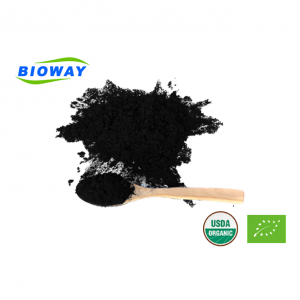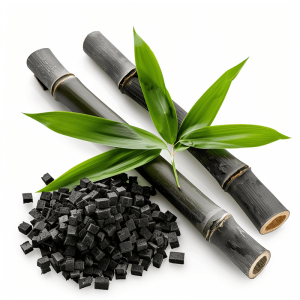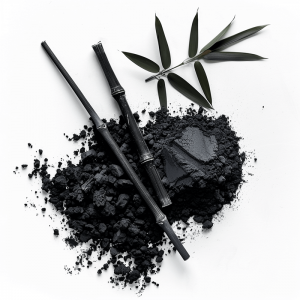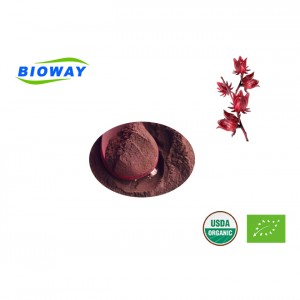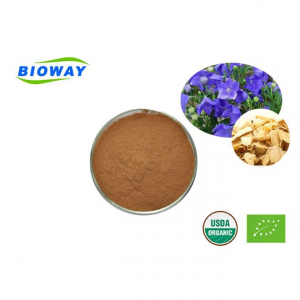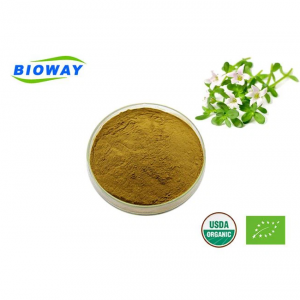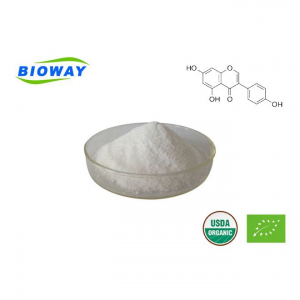Vegetable Carbon Black from Bamboo
The vegetable carbon black, also named E153, Carbon black, vegetable black, carbo medicinalis vegetabilis, is made from plant sources (bamboo, coconut shells, wood) through refining techniques like high-temperature carbonization and ultrafine grinding is a natural pigment with great covering and coloring abilities.
Our vegetable carbon black is indeed a natural pigment that is derived from green bamboo and is known for its strong covering and coloring abilities, making it a popular choice in food coloring, cosmetics, and other industrial applications. Its natural origin and desirable properties make it a valuable ingredient in various products.
The E153 is a food additive, that the European Union (EU) and Canadian authorities have approved. However, it is prohibited in the United States, as the FDA does not approve its use. Contact us for more information: grace@biowaycn.com.
| Product Name | item number | Grade | Specification | Package | ||||
| Vegetable Carbon Black | HN-VCB200S | Great Coloring Power | UItrafine (D90<10μm) | 10kg/fiber drum | ||||
| 100g/paper can | ||||||||
| 260g/bag | ||||||||
| HN-VCB100S | Good Coloring Power | 20kg/fiber drum | ||||||
| 500g/bag | ||||||||
| Serial Number | Test Item(S) | Skills Requirement | Test Result(s) | Individual Judgment | |||
| 1 | Color、Smell、State | Black、Odourless、Powder | Normal | Conforms | |||
| 2 | Dry reduction,w/% | ≤12.0 | 3.5 | Conforms | |||
| 3 | Carbon content,w/%(on a dry basis | ≥95 | 97.6 | Conforms | |||
| 4 | Sulphated ash,w/% | ≤4.0 | 2.4 | Conforms | |||
| 5 | Alkali-soluble coloring matter | Passed | Passed | Conforms | |||
| 6 | Advanced aromatic hydrocarbons | Passed | Passed | Conforms | |||
| 7 | Lead(Pb), mg/kg | ≤10 | 0.173 | Conforms | |||
| 8 | Total arsenic(As),mg/kg | ≤3 | 0.35 | Conforms | |||
| 9 | Mercury (Hg), mg/kg | ≤1 | 0.00637 | Conforms | |||
| 10 | Cadmium(Cd), mg/kg | ≤1 | <0.003 | Conforms | |||
| 11 | Identification | Solubility | Appendix A.2.1 of GB28308-2012 | Passed | Conforms | ||
| Burning | Appendix A.2.2 of GB28308-2012 | Passed | Conforms | ||||
The product features of vegetable carbon black from bamboo may include:
(1) Natural and sustainable: Made from bamboo, a renewable and eco-friendly resource.
(2) High-quality colorant: Produces a bright and attractive black pigment suitable for various applications.
(3) Versatile usage: Can be used in food, cosmetics, and other consumer products.
(4) Free from chemicals: Produced through a natural process without the use of synthetic additives or chemicals.
(5) Exquisite appearance: Provides a deep, rich color with a fine texture and matte finish.
(6) Safe and non-toxic: Suitable for use in products intended for human consumption or contact.
Here are some important functions and potential health benefits of vegetable carbon black from bamboo:
1. Natural Coloring Agent: Vegetable carbon black from bamboo is used as a food colorant in various food and beverage products to provide a rich, deep black hue. This natural coloring agent can enhance the visual appeal of food products without the use of synthetic dyes.
2. Antioxidant Properties: Bamboo-derived carbon black may contain natural antioxidants that can help protect the body from oxidative stress and free radical damage. Antioxidants are known for their potential to support overall health and well-being.
3. Digestive Health Support: Bamboo-derived carbon black may contain dietary fiber, which can contribute to digestive health by promoting regularity and supporting healthy gut function.
Detoxification Support: Some types of vegetable carbon black from bamboo may have detoxifying properties that can help support the body's natural detox processes. This can be beneficial for overall health and well-being.
4. Sustainable and Natural Source: As a product derived from bamboo, vegetable carbon black offers the benefit of being a sustainable and environmentally friendly alternative to synthetic coloring agents. This natural origin can resonate with consumers seeking clean-label, natural food products.
5. Potential Skin Health Benefits: In some cosmetic and skin care products, vegetable carbon black from bamboo may be used for its potential skin-purifying and detoxifying properties. It can help draw out impurities and promote a clearer complexion.
It's important to note that while vegetable carbon black from bamboo may offer potential health benefits, it's essential to use it in moderation and as part of a balanced diet. As with any ingredient, individuals with specific dietary restrictions, allergies, or sensitivities should consult with a healthcare professional before consuming products containing vegetable carbon black from bamboo.
Here's a potential applications list of vegetable carbon black from bamboo:
(1)Food and Beverage Industry:
Natural Food Coloring: Used as a natural black food colorant in products such as pasta, noodles, sauces, confectionery, beverages, and processed foods to achieve an appealing visual appearance.
Food Additive: Incorporation into food products to enhance black color without the use of synthetic additives, offering a clean-label solution for manufacturers.
(2)Dietary Supplements:
Capsules and Tablets: Used as a natural coloring agent in the production of dietary supplements, including herbal supplements and health products, to create visually distinct and attractive formulations.
(3)Cosmetics and Personal Care Products:
Natural Pigment: Utilized in the formulation of natural and organic cosmetics, including eyeliners, mascaras, lipsticks, and skincare products for their black pigment properties.
Skin Detoxification: Included in facial masks, scrubs, and cleansers for its potential detoxifying and purifying effects on the skin.
(4)Pharmaceutical Applications:
Coloring Agent: Employed in pharmaceutical formulations to impart black color to capsules, tablets, and other medicinal products, offering a natural alternative to synthetic dyes.
Herbal Preparations: Incorporated into herbal remedies and traditional medicines for their colorant properties, especially in formulations that emphasize natural ingredients.
(5)Industrial and Technical Applications:
Ink and Dye Production: Used as a natural pigment in the manufacturing of inks, dyes, and coatings for textiles, paper, and other industrial applications.
Environmental Remediation: Utilized in environmental and filtration technologies for its adsorptive properties, including water and air purification systems.
(6)Agricultural and Horticultural Uses:
Soil Amendment: Incorporated into soil amendments and horticultural products to enhance soil properties and promote plant growth in organic and sustainable agricultural practices.
Seed Coating: Applied as a natural seed coating for improved germination, protection, and sustainable farming practices.
It's important to note that the specific applications of vegetable carbon black from bamboo may vary based on regional regulations, product formulations, and industry-specific requirements. Additionally, the potential health benefits and safety aspects of its various applications should be assessed under relevant guidelines and standards.
| Food No | Food names | Maximum addition,g/kg | |||||||
| Item numberHN-FPA7501S | Item numberHN-FPA5001S | Item numberHN-FPA1001S | ltem number(货号)HN-FPB3001S | ||||||
| 01.02.02 | Flavored fermented milk | 6.5 | 10.0 | 50.0 | 16.6 | ||||
| 3.0 | Frozen drinks except edible ice(03.04) | ||||||||
| 04.05.02.01 | Cooked nuts and seeds-Only for fried nuts and seeds | ||||||||
| 5.02 | Candy | ||||||||
| 7.02 | Pastries | ||||||||
| 7.03 | Biscuits | ||||||||
| 12.10 | Compound seasoning | ||||||||
| 16.06 | Puffed food | ||||||||
| Food No. | Food names | Maximum addition,g/kg |
| 3.0 | Frozen drinks except edible ice(03.04) | 5 |
| 5.02 | Candy | 5 |
| 06.05.02.04 | Tapioca pearls | 1.5 |
| 7.02 | Pastries | 5 |
| 7.03 | Biscuits | 5 |
| 16.03 | Collagen casings | Use according to production demand |
| 04.04.01.02 | Dried bean curd | Appropriate use according to production needs |
| 04.05.02 | Processed nuts and seeds | Appropriate use according to production needs |
| 12.10 | Compound seasoning | 5 |
| 16.06 | Puffed food | 5 |
| 01.02.02 | Flavored fermented milk | 5 |
| 04.01.02.05 | Jam | 5 |
The production process of vegetable carbon black from bamboo typically involves several key steps:
1. Bamboo sourcing: The process starts with sourcing and harvesting bamboo, which is then transported to the production facility.
2. Pre-treatment: The bamboo is usually pre-treated to remove impurities, such as dirt and other organic materials, and to optimize the material for subsequent processing.
3. Carbonization: The pre-treated bamboo is then subjected to a high-temperature carbonization process in the absence of oxygen. This process transforms the bamboo into charcoal.
4. Activation: The charcoal is activated through a process that involves exposing it to an oxidizing gas, steam, or chemicals to increase its surface area and enhance its adsorptive properties.
5. Grinding and milling: The activated charcoal is ground and milled to achieve the desired particle size distribution.
6. Purification and classification: The ground charcoal is further purified and classified to remove any remaining impurities and to ensure uniform particle size distribution.
7. Final product packaging: The purified vegetable carbon black is then packaged for distribution and use in various applications, such as food processing, decolorization, and environmental remediation.
Package: 10kg/fiber drum; 100g/paper can; 260g/bag; 20kg/fiber drum; 500g/bag;
Express
Under 100kg, 3-5Days
Door to door service easy to pick up the goods
By Sea
Over300kg, Around 30 Days
Port to port service professional clearance broker needed
By Air
100kg-1000kg, 5-7Days
Airport to airport service professional clearance broker needed

Vegetable Carbon Black Powder is certified by ISO, HALAL, and KOSHER certificates.

To make activated charcoal from bamboo, you can follow these general steps:
Bamboo sourcing: Obtain bamboo that is suitable for charcoal production and ensure it is free from contaminants.
Carbonization: Heat the bamboo in a low-oxygen environment to carbonize it. This process involves heating the bamboo at high temperatures (around 800-1000°C) to drive off volatile compounds and leave behind carbonized material.
Activation: The carbonized bamboo is then activated to create pores and increase its surface area. This can be achieved through physical activation (using gases like steam) or chemical activation (using various chemicals like phosphoric acid or zinc chloride).
Washing and drying: After activation, wash the bamboo charcoal to remove any impurities or leftover activation agents. Then, dry it thoroughly.
Sizing and packaging: The activated charcoal can be ground to the desired particle size distribution and packaged for use in various applications.
It's important to note that the specific details of the process may vary based on the resources and equipment available, as well as the intended use of the activated charcoal. Additionally, proper safety measures should be observed when working with high temperatures and chemicals.
Yes, vegetable carbon, also known as activated charcoal made from plant sources, is generally safe to eat when used in moderate amounts. It is commonly used in food and dietary supplements as a natural colorant and for its purported detoxifying properties. However, it's important to use it according to the recommended usage guidelines, as excessive consumption may interfere with the absorption of nutrients and medications. As with any dietary supplement, it's advisable to consult with a healthcare professional before using activated charcoal, especially if you have any underlying health conditions or are taking medications.
Activated charcoal is generally considered safe when used in appropriate amounts for medical purposes, such as in cases of poisoning or overdose. However, side effects may occur, including constipation or diarrhea, vomiting, black stools, and gastrointestinal discomfort. It's important to note that activated charcoal can interfere with the absorption of medications and nutrients, so it should be taken at least two hours before or after other medications or supplements. As with any supplement or medication, it's essential to consult with a healthcare professional before using activated charcoal, especially if you have any underlying health conditions or are taking medications.
Black is a color, while carbon black is a material. Black is a color that is found in nature and can also be produced through the combination of different pigments. On the other hand, carbon black is a form of elemental carbon that is produced through incomplete combustion of heavy petroleum products or plant sources. Carbon black is commonly used as a pigment in inks, coatings, and rubber products due to its high tinting strength and color stability.
Activated charcoal is not banned. It is widely used in various industries and applications, including as a filtering agent, in medicine for treating certain types of poisoning, and in skincare products for its purifying properties. However, it is important to use activated charcoal under guidelines and recommendations to ensure its safe and effective use.
However, the FDA has prohibited the use of activated charcoal as a food additive or coloring agent due to concerns about its potential interactions with medications and the possibility of interference with nutrient absorption in the body. While activated charcoal is considered safe for certain uses, its use in food products is not approved by the FDA. As a result, its use as an ingredient in food and beverages is not permitted under current regulations.


